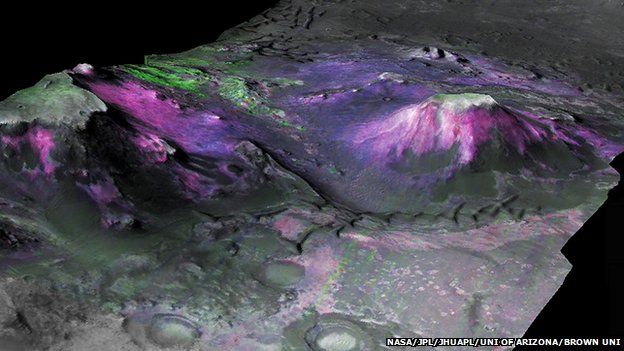Clays in Pacific lavas challenge wet early Mars idea
- Published

A study of rocks at an old A-bomb test site in the Pacific has led a team of scientists to conclude that early Mars was not so warm and wet as many argue.
The rocks at Mururoa Atoll in French Polynesia contain clay minerals that look like those seen on the Red Planet.
But whereas the Martian clays are taken to be the products of weathering of rocks by liquid water, the atoll's clays have a very different origin.
These were precipitated directly from water-rich molten rock as it cooled.
The research is published in Nature Geoscience by Prof Alain Meunier from the University of Poitiers, France, and colleagues.
It is interesting because it strikes at the heart of the notion that the Red Planet was awash with water, perhaps at its surface, more than 3.75 billion years ago - an idea that has been put forward to explain the great abundance of some clay deposits observed from orbit by satellites.
However, the process of clay production at Mururoa, if replicated and widespread on early Mars, would remove the need for such large volumes of water, and with it possibly a more benign environment for life to establish itself on the planet.
"Mars was not as warm and wet in its earliest time as some have suggested. I do not believe in an early ocean on Mars," Prof Meunier told BBC News.
But [the Mururoa process] explains only the earliest generation of clays on Mars, in the early Noachian period. In later periods, liquid water has existed on Mars' surface; that is undoubtedly the case."
Free space
The atoll was the site of French nuclear testing from the 1960s to the 1990s.
A lot of rock was drilled from the island as part of that programme and is now available for study.
Prof Meunier's team shows that clays in these volcanic samples were formed directly in place, in the spaces that sometimes arise between cooling rock crystals. They were not the product of later alteration of the rock through long-term contact with water - the more familiar route to these minerals.
"Inside the basaltic rock as the lava is cooling, the crystals are separated sometimes by free spaces in which the residual fluids are concentrated," Prof Meunier explained.
"These fluids contain all the components that have not been consumed in the high-temperature crystals like pyroxene, olivine and plagioclase; and among these components, of course, there is water.
"As the temperature decreases, these fluids are supersaturated with a lot of phases that consume water and all the remaining elements. And this favours the formation of clay minerals."
What is more, when the team examined the infrared reflectance of the Mururoan lavas, they found the signal to be very similar to the observational data obtained by the Mars orbiters that have mapped the Red Planet's clay deposits.
Below the surface
Prof John Mustard, of Brown University, Rhodes Island, US, has studied the satellite clay data extensively since its first acquisition in 2005.
He said the new research was a welcome addition to the debate about the early environmental conditions on the planet but that he was not convinced the Mururoan lavas could explain the great abundance of clays seen in some regions of the Red Planet.
"The question is: how do you generate thick sequences of this stuff? Their model cannot, I don't think, explain a Mawrth Vallis and other thick sections where we can quite clearly demonstrate many hundreds of metres, if not more, of clay formation. Mawrth Vallis has far too much clay to be produced by this process. The amount of clays produced by this degassing process is a relatively small amount."
Prof Mustard himself prefers the idea that many of the clays were produced sub-surface at Mars, where warm water could interact with rocks for long periods - such as in hydrothermal systems. Only later were these buried clays excavated into view by impacts or through the erosion of overlying ground by short-lived bursts of flowing surface water.
To maintain stable water on the surface of the planet for extended durations would have needed a thick atmosphere - something which is quite hard to reproduce in the climate models of early Mars, explained Prof Mustard.
"We make the clear argument that a good chunk of the clays were subsurface," he told BBC News.
"I think it's abundantly clear that surface hydrologic systems were probably responsible for a subset of the clay occurrences that we see - but not the dominance. There's very good evidence for there having been interconnected rivers and lakes, but they're very immature. This fluvial renaissance of Mars was very short-lived."
The debate is about to get lot more interesting thanks to the imminent first direct measurements of clay minerals on Mars.
Nasa has two operational rovers on the planet currently, and both should encounter the deposits.
The Opportunity vehicle is driving around the rim of a big crater known as Endeavour where clays have been sighted from orbit.
And the Curiosity robot, which has just landed in Gale Crater, will be commanded to drive to the base of a mountain where, again, clays have been detected by satellite.
Jonathan.Amos-INTERNET@bbc.co.uk and follow me on Twitter
- Published6 September 2012
- Published4 August 2012
- Published17 July 2008